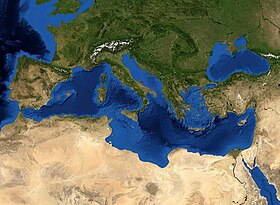
Back Iërupa Seulatan ACE Suid-Europa Afrikaans ደቡባዊ አውሮፓ Amharic Europa d'o Sud AN أوروبا الجنوبية Arabic Europa Meridional AST Geefa Europa AVK दक्खिनी यूरोप AWA Cənubi Avropa Azerbaijani جنوبی اوروپا AZB

Southern Europe is the southern region of Europe.[1] It is also known as Mediterranean Europe, as its geography is marked by the Mediterranean Sea. Definitions of southern Europe include some or all of these countries and regions: Albania, Andorra, Bosnia and Herzegovina, Bulgaria,[note 1] Croatia, Cyprus,[note 2] Gibraltar,[note 3] Greece,[note 4] Italy,[note 5] Kosovo, Malta,[note 6] Monaco,[note 7] Montenegro, North Macedonia, Portugal, San Marino, Serbia, Slovenia, southern France,[note 8] Spain, Turkey (East Thrace),[note 9] and Vatican City.[4][5][6][7][8][9][10][11]
Southern Europe is focused on the three peninsulas located in the extreme south of the European continent. These are the Iberian Peninsula, the Apennine Peninsula, and the Balkan Peninsula.[12][13] These three peninsulas are separated from the rest of Europe by towering mountain ranges, respectively by the Pyrenees, the Alps and the Balkan Mountains. The location of these peninsulas in the heart of the Mediterranean Sea, as well as their mountainous reliefs, provide them with very different types of climates (mainly subtropical Mediterranean) from the rest of the continent. So, the Sirocco hot wind that originates in the heart of the Sahara blows over Italy, going up to the interior of the Alpine arc (Po Valley). The Alps prevent the Sirocco from spreading to the rest of Europe. And, conversely, the Alps and the Pyrenees protect the Italian and Iberian Peninsulas from the rains and icy winds from the south of France such as the Mistral and the Tramontane. When the Mistral and the Tramontane are blowing, this provokes an "upwelling" phenomenon on the French coast. They push the surface waters out to sea and bring deeper, cooler waters up to the seaside. Consequently, the temperature of the waters of the French coasts are therefore very cool even in summer, and not representative of the rest of the Mediterranean.[14][15][16] This same kind of phenomenon takes place between the two slopes of the Balkan mountain range. These mountains have, moreover, been a serious handicap to population displacement, focusing southern Europe mainly on the Mediterranean world. The climate and cultures are therefore very specific.
Different methods can be used to define southern Europe, including its political, economic, historical, and cultural attributes. Southern Europe can also be defined by its natural features — its geography, climate, and flora. Politically, nine of the southern European countries form the EU Med Group. Southern Europe also loosely corresponds to the European part of the Mediterranean Basin.
- ^ Southern Europe
- ^ a b c Taylor Combaluzier. "African & Arabian Tectonic Plates". McGill University, Montréal. Retrieved 18 June 2022.
- ^ a b Galea, Pauline (2007). "Seismic history of the Maltese Islands and considerations on seismic risk: Earthquakes in Malta". Annals of Geophysics. 50 (6): 725–740. Retrieved 5 June 2015.
- ^ Trudy Ring; Noelle Watson; Paul Schellinger (5 November 2013). Southern Europe: International Dictionary of Historic Places. Taylor & Francis. ISBN 978-1-134-25965-6.
- ^ José María Magone; Magone, José María Magone (2003). The Politics of Southern Europe: Integration Into the European Union. Greenwood Publishing Group. pp. 292–. ISBN 978-0-275-97787-0.
- ^ Europe, Southern: Italy, Cyprus, Greece, European Turkey: Selected References. Air University Library. 1992.
- ^ Encyclopedia of Social and Cultural Anthropology, Alan Barnard and Jonathan Spence. Retrieved 10 October 2015.
- ^ UCF Libraries – Southern Europe
- ^ Which Countries Make Up Southern Europe? WorldAtlas
- ^ "Global Forest Resources Assessment 2000 - Chapter 30. Southern Europe". Food and Agriculture Organization of the United Nations. 2000. Retrieved 26 November 2021.
- ^ Romania | History, Map, & Facts | Britannica
- ^ Robert E. Dickinson (1969). The Makers of Modern Geography. Routledge Library Editions: Social and Cultural Geography. p. 16. ISBN 9781317907336.
He (August Zeune) divided Europe into its major divisions. Southern Europe falls into three units — the Pyrenean, Alpine, and Balkan peninsulas.
- ^ "Europe: Physical Geography". National Geographic Society. 4 January 2012. Retrieved 21 February 2022.
Europe's main peninsulas are the Iberian, Italian, and Balkan, located in southern Europe
- ^ "Mediterranean sea-surface temperature". ESA. 2012. Retrieved 19 November 2021.
- ^ Barale, Vittorio (January 2011). "Fig. 3.a: Sea surface temperature of the Mediterranean Sea (water masses and physical processes)". The coastal dimension of maritime spatial planning. ResearchGate. Archived from the original on 23 April 2023. Retrieved 4 September 2021.
- ^ "2010-2019 SST in the Mediterranean". eo science for society. 24 June 2019. Retrieved 19 November 2021.
Cite error: There are <ref group=note> tags on this page, but the references will not show without a {{reflist|group=note}} template (see the help page).
© MMXXIII Rich X Search. We shall prevail. All rights reserved. Rich X Search